Personalization of the Car-Sharing Fleet Selected for Commuting to Work or for Educational Purposes—An Opportunity to Increase the Attractiveness of Systems in Smart Cities
Abstract
:1. Introduction
- Ride-sharing services, like those offered by Uber and Lyft, enable multiple passengers to share a single vehicle for their journeys, reducing the number of cars on the road and consequently lowering emissions and traffic congestion. These services are enhanced by sophisticated algorithms that optimize routes and match passengers traveling in the same direction, improving user efficiency and convenience [3].
- Bike-sharing systems provide an environmentally friendly and health-promoting alternative for short-distance travel. Users can pick up a bike from one station and drop it off at another, making it a flexible option for navigating urban environments [4]. This mode of transport not only reduces carbon emissions but also helps alleviate traffic congestion [4].
- Scooter-sharing has emerged as a popular option for short, spontaneous trips in many cities [5]. Electric scooters can be rented using mobile apps, offering a convenient and sustainable solution to last-mile connectivity [5]. These systems often complement public transportation by solving the problem of reaching destinations that are not accessible directly by bus or train [5].
- Car-sharing is a service that provides members with access to a fleet of vehicles on a short-term, as-needed basis [6]. Unlike traditional car rental services, which typically cater to longer rental periods and often involve visiting a rental location, car sharing is designed for short-term use, often measured in minutes or hours, and vehicles are typically located within local neighborhoods for easy access [6].
- A theoretical gap, stemming from a scarcity of detailed studies on the utility of car-sharing fleets and the selection of appropriate vehicles, coupled with a lack of clear definitions for fleet requirements and parameters;
- A methodological gap, characterized by the absence of standardized tools and methods for assessing the utility of car-sharing fleets;
- An empirical gap, related to insufficient research and observations on how societies perceive car-sharing vehicles;
- A practical gap due to the absence of tailored recommendations for car-sharing system operators.
- Systematizing knowledge concerning the operation of car-sharing systems within urban transportation networks, spanning technical, organizational, economic, and environmental aspects;
- Establishing indicators for the utilization of vehicle fleets in car-sharing systems,
- Elucidating the purposes for using car-sharing services and the criteria for segmenting customers of such systems;
- Formulating rules for calculating the overall utility of car attributes tailored to different customer segments of car-sharing services;
- Assessing the relative importance of attributes in customer decisions when choosing car-sharing services based on specific vehicles;
- Outlining the rules for the composition of vehicles in a car-sharing fleet;
- Developing recommendations for the selection of vehicle fleets for car-sharing.
2. Methods
Procedural Steps in the Methodology
- The business model under which the car-sharing operator functions;
- The operating model of the car-sharing service;
- The geographic areas where the car-sharing service operates;
- The pricing structure for vehicle rentals offered by the operator;
- The types of rentals available.
- EURO Car Segment, which categorizes vehicles into classes commonly used in Europe, such as passenger cars or vans, each designated for specific functions or characteristics [57],
- EURO NCAP class, which defines vehicle sizes based on assessments by the European New Car Assessment Programme (EURO NCAP), an independent non-profit organization focused on vehicle safety, supported by various entities and some European government bodies [58],
- US EPA Size Class, a system used predominantly in North America that categorizes vehicle sizes as defined by the Environmental Protection Agency (EPA), an independent U.S. federal agency charged with environmental protection [59],
- A common colloquial classification used within the car-sharing community likens vehicle sizes to clothing sizes, making it easier for users to identify vehicles without the need to understand specific automotive classifications.
- Wide geographic and demographic reach: CAWI enables access to a large number of geographically dispersed respondents, a feat challenging to achieve with traditional methods such as in-person or telephone interviews.
- Cost reduction: The CAWI method is more cost-effective than traditional survey methods. Cost savings arise from the elimination of the need for interviewers’ physical presence, travel expenses, and lower data processing costs due to electronic collection and processing of responses.
- Homogeneity and consistency of data: Online surveys ensure that all respondents receive questions in the same form and order, minimizing the risk of subjective errors by the interviewer in the formulation of questions and instructions.
- Speed of data collection and processing: Data are collected in real time, allowing immediate analysis and application in ongoing decisions. This method eliminates delays typically associated with manual data entry found in paper surveys.
- Increased response rates from specific demographic groups: Younger generations, who may find traditional research methods challenging, are more likely to participate in online surveys. This attribute makes CAWI particularly effective in researching new technologies or consumer trends, which is vital in studies on car-sharing services that leverage digital technologies.
- Anonymity and respondent comfort: Online surveys can be conducted anonymously, encouraging more honest responses, particularly on sensitive topics. Additionally, respondents can complete surveys at their convenience, enhancing their comfort and willingness to participate.
3. Results
3.1. Computational Stage for the Analyzed Case Study
3.2. Research Results for the Purpose of Using a Car-Sharing Vehicle for Commuting to Work or to a Place of Education
4. Discussion
4.1. Transferability of the Results to the Shared Mobility Market
4.2. Research Implications
- (1)
- Fleet Optimization:
- Expansion of the vehicle fleet to include a greater proportion of class D and E vehicles to accommodate user preferences for enhanced travel comfort and versatility.
- Strategic planning to ensure an adequate supply of larger vehicles during peak commuting hours to meet demand fluctuations effectively.
- (2)
- Flexible Pricing Strategies:
- Implementation of dynamic pricing mechanisms to align rental costs with user expectations, particularly in terms of per-kilometer pricing, ideally falling within the range of EUR 0.40 to EUR 0.60.
- Consideration of flexible pricing structures to offer competitive rates during peak demand periods, thereby enhancing service appeal and utilization.
- (3)
- Integration of Sustainable Mobility Solutions:
- Promotion of sustainability by increasing the deployment of hybrid and electric vehicles within car-sharing fleets, reflecting a growing consumer preference for eco-friendly transportation options.
- Investment in the expansion of electric vehicle charging infrastructure across smart city networks to facilitate widespread adoption and accessibility of environmentally conscious mobility alternatives.
- (4)
- Enhancement of Vehicle Features:
- Upgrading vehicle specifications to meet user expectations for comfort and convenience, including the integration of advanced technologies and amenities such as navigation systems and internet connectivity.
- Adoption of a user-centric approach to vehicle design and outfitting to ensure optimal user experience and satisfaction.
- (5)
- Educational Initiatives and Marketing:
- Implementation of educational campaigns to underscore the societal benefits of car-sharing in smart cities, emphasizing reductions in traffic congestion, carbon emissions, and transportation expenses.
- Promotion of a culture of resource sharing in transportation as a cornerstone of sustainable urban development, fostering increased public awareness and acceptance of car sharing as a viable mobility solution.
- (6)
- Policy implications:
- The emphasis on safety as the dominant issue among respondents emphasizes the need to introduce strict regulations and safety standards for car-sharing vehicles. Decision-makers should prioritize checking the technical condition of vehicles and require daily maintenance of vehicles to eliminate possible irregularities before using users’ cars. Ensuring that shared vehicle fleets meet high safety standards will be consistent with the overarching goals of smart cities to provide safe mobility solutions.
- Users’ preference for larger vehicles highlights the need for consultation between area operators to validate their fleet composition. Moreover, this indicates that it is also necessary to develop policies specifying the principles of fleet selection to meet the expectations of individual user groups. This type of procedure will make the use of car-sharing services a real transport option for those interested and will meet their needs.
- Findings regarding the importance of the level of vehicle equipment standards indicate the importance of integrating advanced technologies and amenities in car-sharing cars. This type of preference is consistent with the general assumptions of smart cities and may contribute to their even faster development.
- The importance of rental prices highlights the need for policies that balance affordability with environmental awareness. Policymakers should promote pricing strategies that make car-sharing services competitively priced with individual car use, while encouraging the use of environmentally friendly transportation options. Incentives for hybrid and electric vehicles in car-sharing fleets can accelerate the transition to sustainable urban mobility, in line with the ethos of smart urban development.
5. Conclusions
Funding
Institutional Review Board Statement
Informed Consent Statement
Data Availability Statement
Conflicts of Interest
Appendix A
- Ladies and Gentlemen,
- As part of the implementation of scientific research on improving the adaptation of the car-sharing fleet of the X company to adopt to the needs of users, I cordially invite you to take part in this survey. This questionnaire is devoted to the utility of individual attributes concerning vehicles and car-sharing systems depending on the purpose of the trip. The survey is addressed to people who occasionally use car-sharing systems, i.e., up to 10 h a year.
- The survey is anonymous and will not take more than 10 min.
- Thank you very much for your participation.
- Katarzyna Turoń, PhD. Eng. DSc.
- Silesian University of Technology,
- Faculty of Transport and Aviation Engineering, Department of Road Transport
- Demographics
- Year of birth: …..
- Sex:
- □
- Female.
- □
- Male.
- Education level:
- □
- Basic.
- □
- Junior high school.
- □
- Basic vocational.
- □
- High school.
- □
- Higher.
- Domicile:
- □
- Village.
- □
- City up to 50,000 residents.
- □
- City up to 100,000 residents.
- □
- City up to 250,000 residents.
- □
- City over 250,000 residents.
- Professional situation:
- □
- Learning.
- □
- Working.
- □
- Unemployed.
- □
- Pensioner.
- □
- Learning and working.
- Family status:
- □
- Bachelor/Maiden.
- □
- Married.
- □
- Divorced.
- Monthly earnings:
- □
- Up to EUR 1500.
- □
- EUR 1501–EUR 2500.
- □
- EUR 2501—EUR 4500.
- □
- Over 4500 EUR.
- Imagine that you have to make several trips using a car from a car-sharing system for commuting to work/school.
- For each trip, you are offered a different type of vehicle defined by six parameters as:
- -
- Car type [-]—Classification that determines the size of the vehicle: small (A, B class), medium (C class), large (D, E class).
- -
- The average car-sharing vehicle rental price [€/km]—the average cost of renting a car per 1 km of travel,
- -
- Engine power [kW]—The amount of work an engine can do in a given time,
- -
- Car-sharing vehicle equipment standard [-]—Additional vehicle equipment that increases the level of its safety, comfort, or vehicle quality.
- -
- Drive type of the vehicle [-]—The type of engine the car is equipped with,
- -
- Euro NCAP rating [-]—Five-star safety rating system to help consumers identify the safest choice for their needs. The safety rating is determined from a series of vehicle tests designed and carried out by the Euro NCAP organization (on a 5-star scale, 1 is the lowest and 5 is the highest safety value).
| 1 unsatisfactory | 2 mediocre | 3 satisfactory | 4 good | 5 very good | 6 excellent |
| # 0 | Purpose: Using of a Car-Sharing Vehicle for Commuting to Work (Including Dealing with Professional Matters and Travel to Business Meetings as Business Daily Trips) or Commuting to Place of Education (e.g., School, University, etc.) | ||||||
| Attributes | Car type [-] | The average car-sharing vehicle rental price [€/km] | Engine power [kW] | Car-sharing vehicle equipment standard [-] | Drive type of the vehicle [-] | Euro NCAP raring [-] | Grade |
| Levels | small | 0.40–0.60 | 63–149 | Parking sensors | Electric engine | 3–4 stars | 6 |
| small | 0.40–0.60 | 40–62 | Parking sensors | Internal Combustion engine | 1–3 stars | 2 | |
| # 1 | Using of a Car-Sharing Vehicle for Commuting to Work (Including Dealing with Professional Matters and Travel to Business Meetings as Business Daily Trips) or Commuting to Place of Education (e.g., School, University, etc.) | ||||||
| Attributes | Car type [-] | The average car-sharing vehicle rental price [€/km] | Engine power [kW] | Car-sharing vehicle equipment standard [-] | Drive type of the vehicle [-] | Euro NCAP rating [-] | Grade |
| Levels | Small | 0.40–0.60 | 63–149 | Parking sensors | Electric engine | 3–4 stars | … |
| Small | 0.40–0.60 | 40–62 | Parking sensors | Internal Combustion Engine | 1–3 stars | … | |
| … | … | … | … | … | … | … | |
| Large | over 0.91 | Over 150 | Parking sensors, navigation, handsfree, lane assistant, heated seats, cruise control | Internal Combustion Engine | 5 stars | … | |
References
- Budnitz, H. Sustainable Mobility. In Encyclopedia of Sustainability in Higher Education; Leal Filho, W., Ed.; Springer International Publishing: Cham, Switzerland, 2019; pp. 1833–1842. [Google Scholar]
- Machado, C.A.S.; De Salles Hue, N.P.M.; Berssaneti, F.T.; Quintanilha, J.A. An Overview of Shared Mobility. Sustainability 2018, 10, 4342. [Google Scholar] [CrossRef]
- Mitropoulos, L.; Kortsari, A.; Ayfantopoulou, G. A Systematic Literature Review of Ride-Sharing Platforms, User Factors and Barriers. Eur. Transp. Res. Rev. 2021, 13, 61. [Google Scholar] [CrossRef]
- Fishman, E. Bikeshare: A Review of Recent Literature. Transp. Rev. 2016, 36, 92–113. [Google Scholar] [CrossRef]
- Badia, H.; Jenelius, E. Shared E-Scooter Micromobility: Review of Use Patterns, Perceptions and Environmental Impacts. Transp. Rev. 2023, 43, 811–837. [Google Scholar] [CrossRef]
- Golalikhani, M.; Oliveira, B.B.; Carravilla, M.A.; Oliveira, J.F.; Antunes, A.P. Carsharing: A Review of Academic Literatureand Business Practices toward an Integrated Decision-Support Framework. Transp. Res. Part E Logist. Transp. Rev. 2021, 149, 102280. [Google Scholar] [CrossRef]
- Guyader, H.; Friman, M.; Olsson, L.E. Shared Mobility: Evolving Practices for Sustainability. Sustainability 2021, 13, 12148. [Google Scholar] [CrossRef]
- Nansubuga, B.; Kowalkowski, C. Carsharing: A Systematic Literature Review and Research Agenda. J. Serv. Manag. 2021, 32, 55–91. [Google Scholar] [CrossRef]
- Shaheen, S.A.; Cohen, A.P. Carsharing and Personal Vehicle Services: Worldwide Market Developments and Emerging Trends. Int. J. Sustain. Transp. 2013, 7, 5–34. [Google Scholar] [CrossRef]
- Firnkorn, J.; Müller, M. What Will Be the Environmental Effects of New Free-Floating Car-Sharing Systems? The Case of Car2go in Ulm. Ecol. Econ. 2011, 70, 1519–1528. [Google Scholar] [CrossRef]
- Litman, T. Not So Fast Better Speed Valuation for Transportation Planning. Available online: https://www.vtpi.org/nsf.pdf (accessed on 3 May 2024).
- Martin, E.W.; Shaheen, S.A. Greenhouse Gas Emission Impacts of Carsharing in North America. IEEE Trans. Intell. Transport. Syst. 2011, 12, 1074–1086. [Google Scholar] [CrossRef]
- George, C.; Julsrud, T.E. Cars and the Sharing Economy: The Emergence and Impacts of Shared Automobility in the Urban Environment. In Advances in Transport Policy and Planning; Elsevier: Amsterdam, The Netherlands, 2019; Volume 4, pp. 7–38. [Google Scholar] [CrossRef]
- Millard-Ball, A.; Murray, G.; Ter Schure, J.; Fox, C.; Burkhardt, J. Car-Sharing: Where and How It Succeeds. Transportation Research Board 2015. Available online: https://nap.nationalacademies.org/read/13559/chapter/1 (accessed on 3 May 2024).
- Ang, F.; Van Passel, S.; Mathijs, E. An Aggregate Resource Efficiency Perspective on Sustainability: A Sustainable Value Application to the EU-15 Countries. Ecol. Econ. 2011, 71, 99–110. [Google Scholar] [CrossRef]
- Hoerler, R.; Van Dijk, J.; Patt, A.; Del Duce, A. Carsharing Experience Fostering Sustainable Car Purchasing? Investigating Car Size and Powertrain Choice. Transp. Res. Part D Transp. Environ. 2021, 96, 102861. [Google Scholar] [CrossRef]
- European Shared Mobility Index. Available online: https://www.linkedin.com/pulse/european-shared-mobility-index-fluctuo/ (accessed on 3 May 2024).
- ING Forecast. Car-Sharing Unlocked. Available online: https://www.ing.nl/zakelijk/kennis-over-de-economie/uw-sector/automotive/car-sharing-unlocked-english.html (accessed on 3 May 2024).
- Research and Markets. Car Sharing Market: Global Industry, Trends, Share, Size, Growth, Opportunity and Forecast 2021–2026. Available online: https://www.researchandmarkets.com/reports/5483424/car-sharing-market-global-industry-trends?gclid=Cj0KCQiAg_KbBhDLARIsANx7wAwu3FD0-eUeYdxZZQ_qtTYEijaNKLC6gwGPSOUPK-_T3J0l7VsLwnwaAvwgEALw_wcB (accessed on 3 May 2024).
- Brendel, A.B.; Brennecke, J.T.; Hillmann, B.M.; Kolbe, L.M. The Design of a Decision Support System for Computation of Carsharing Pricing Areas and Its Influence on Vehicle Distribution. IEEE Trans. Eng. Manag. 2023, 70, 819–833. [Google Scholar] [CrossRef]
- Zhang, X.; Shao, C.; Wang, B.; Huang, S.; Mi, X.; Zhuang, Y. Exploring the Role of Shared Mobility in Alleviating Private Car Dependence and On-Road Carbon Emissions in the Context of COVID-19. Front. Environ. Sci. 2022, 10, 931763. [Google Scholar] [CrossRef]
- Barrios, J.A.; Godier, J.D. Fleet Sizing for Flexible Carsharing Systems: Simulation-Based Approach. Transp. Res. Rec. 2014, 2416, 1–9. [Google Scholar] [CrossRef]
- Carlier, A.; Munier-Kordon, A.; Klaudel, W. Optimization of a one-way carsharing system with relocation operations. In Proceedings of the 10th International Conference on Modeling, Optimization and SIMulation MOSIM 2014, Nancy, France, 5 November 2014. [Google Scholar]
- Martin, G.; Donain, M.; Fromont, E.; Guns, T.; Roze, L.; Termier, A. Prediction-Based Fleet Relocation for Free Floating Car Sharing Services. In Proceedings of the 2021 IEEE 33rd International Conference on Tools with Artificial Intelligence (ICTAI), Washington, DC, USA, 1–3 November 2021; IEEE: Washington, DC, USA, 2021; pp. 1187–1191. [Google Scholar]
- Huang, K.; An, K.; Correia, G.H.d.A. Planning Station Capacity and Fleet Size of One-Way Electric Carsharing Systems with Continuous State of Charge Functions. Eur. J. Oper. Res. 2020, 287, 1075–1091. [Google Scholar] [CrossRef]
- Fanti, M.P.; Mangini, A.M.; Pedroncelli, G.; Ukovich, W. Fleet Sizing for Electric Car Sharing System via Closed Queueing Networks. In Proceedings of the 2014 IEEE International Conference on Systems, Man, and Cybernetics (SMC), San Diego, CA, USA, 5–8 October 2014; IEEE: San Diego, CA, USA, 2014; pp. 1324–1329. [Google Scholar] [CrossRef]
- Monteiro, C.M.; Machado, C.A.S.; Lage, M.D.O.; Berssaneti, F.T.; Davis, C.A.; Quintanilha, J.A. Optimization of Carsharing Fleet Size to Maximize the Number of Clients Served. Comput. Environ. Urban Syst. 2021, 87, 101623. [Google Scholar] [CrossRef]
- Nourinejad, M.; Roorda, M.J. A dynamic carsharing decision support system. Transp. Res. Part E Logist. Transp. Rev. 2014, 66, 36–50. [Google Scholar] [CrossRef]
- Ströhle, P.; Flath, C.M.; Gärttner, J. Leveraging Customer Flexibility for Car-Sharing Fleet Optimization. Transp. Sci. 2019, 53, 42–61. [Google Scholar] [CrossRef]
- Deng, Y.; Gupta, A.K.; Shroff, N.B. Fleet Sizing and Charger Allocation in Electric Vehicle Sharing Systems. IFAC J. Syst. Control 2020, 22, 100210. [Google Scholar] [CrossRef]
- Bazan, P.; Djanatliev, A.; Pruckner, M.; German, R.; Lauer, C. Rebalancing And Fleet Sizing Of Mobility-On-Demand Networks With Combined Simulation, Optimization And Queueing Network Analysis. In Proceedings of the 2018 Winter Simulation Conference (WSC), Gothenburg, Sweden, 9–12 December 2018; pp. 1527–1538. [Google Scholar]
- Xu, M.; Meng, Q. Fleet Sizing for One-Way Electric Carsharing Services Considering Dynamic Vehicle Relocation and Nonlinear Charging Profile. Transp. Res. Part B Methodol. 2019, 128, 23–49. [Google Scholar] [CrossRef]
- Liao, F.; Correia, G. Electric Carsharing and Micromobility: A Literature Review on Their Usage Pattern, Demand, and Potential Impacts. Int. J. Sustain. Transp. 2022, 16, 269–286. [Google Scholar] [CrossRef]
- Shaheen, S.; Martin, E.; Totte, H. Zero-Emission Vehicle Exposure within U.S. Carsharing Fleets and Impacts on Sentiment toward Electric-Drive Vehicles. Transp. Policy 2020, 85, A23–A32. [Google Scholar] [CrossRef]
- Schlüter, J.; Weyer, J. Car Sharing as a Means to Raise Acceptance of Electric Vehicles: An Empirical Study on Regime Change in Automobility. Transp. Res. Part F Traffic Psychol. Behav. 2019, 60, 185–201. [Google Scholar] [CrossRef]
- Campisi, T.; Ignaccolo, M.; Tesoriere, G.; Inturri, G.; Torrisi, V. The Evaluation of Car-Sharing to Raise Acceptance of Electric Vehicles: Evidences from an Italian Survey among University Students. SAE Tech. Pap. 2020. [Google Scholar] [CrossRef]
- Migliore, M.; D’Orso, G.; Caminiti, D. The environmental benefits of carsharing: The case study of Palermo. Transp. Res. Procedia 2020, 48, 2127–2139. [Google Scholar] [CrossRef]
- Hui, Y.; Wang, Y.; Sun, Q.; Tang, L. The Impact of Car-Sharing on the Willingness to Postpone a Car Purchase: A Case Study in Hangzhou, China. J. Adv. Transp. 2019, 2019, 1–11. [Google Scholar] [CrossRef]
- Jochem, P.; Frankenhauser, D.; Ewald, L.; Ensslen, A.; Fromm, H. Does Free-Floating Carsharing Reduce Private Vehicle Ownership? The Case of SHARE NOW in European Cities. Transp. Res. Part A Policy Pract. 2020, 141, 373–395. [Google Scholar] [CrossRef]
- Jain, T.; Rose, G.; Johnson, M. Changes in Private Car Ownership Associated with Car Sharing: Gauging Differences by Residential Location and Car Share Typology. Transportation 2022, 49, 1–25. [Google Scholar] [CrossRef] [PubMed]
- Liao, F.; Molin, E.; Timmermans, H.; Van Wee, B. Carsharing: The Impact of System Characteristics on Its Potential to Replace Private Car Trips and Reduce Car Ownership. Transportation 2020, 47, 935–970. [Google Scholar] [CrossRef]
- Kubik, A.; Turoń, K.; Stanik, Z. Car-sharing systems vehicles versus taxis in urban transport system—Legal requirements, technical service, operation. In Proceedings of the International Conference on Traffic and Transport Engineering: ICTTE, Belgrade, Serbia, 27–28 September 2018; Cokorilo, O., Ed.; City Net Scientific Research Center: Belgrade, Serbia, 2018. [Google Scholar]
- Kubik, A.; Turoń, K.; Folęga, P.; Chen, F. CO2 Emissions—Evidence from Internal Combustion and Electric Engine Vehicles from Car-Sharing Systems. Energies 2023, 6, 2185. [Google Scholar] [CrossRef]
- Bruglieri, M.; Pisacane, O. A Survey on Emergent Trends in the Optimization of Car-sharing Systems. Int. Trans. Oper. Res. 2023, 30, 2867–2908. [Google Scholar] [CrossRef]
- Tchorek, G.; Targowski, F. Car Sharing in Poland—The Perspective of Operators and Cities in the First Comparative Research Study. Studia i Materiały 2019, 2, 47–63. [Google Scholar] [CrossRef]
- Turoń, K. Carsharing Vehicle Fleet Selection from the Frequent User’s Point of View. Energies 2022, 15, 6166. [Google Scholar] [CrossRef]
- Turoń, K. Car-sharing problems—Multi-criteria overview. In Proceedings of the International Conference on Traffic and Transport Engineering. ICTTE, Belgrade, Serbia, 27–28 September 2018; Cokorilo, O., Ed.; City Net Scientific Research Center: Belgrade, Serbia, 2018; pp. 916–922. [Google Scholar]
- Cooke, P.N. Zarządzanie flotą samochodową. Strategie; IPM: Wrocław, Poland, 2005; ISBN 83-921812-1-2. [Google Scholar]
- Sharma, A.; Shukla, D. Perception of Consumers Towards Car Purchase Decision. SSRN J. 2019. [Google Scholar] [CrossRef]
- Begg, D.; Fisher, S. Mikroekonomia; Polskie Wydawnictwo Ekonomiczne: Warszawa, Poland, 2008; ISBN 9788320820881. [Google Scholar]
- Walesiak, M.; Bąk, A. Conjoint analysis w badaniach marketingowych; Wydawnictwo Akademii Ekonomicznej we Wrocławiu: Wrocław, Poland, 2000; ISBN 8370114415. [Google Scholar]
- Alriksson, S.; Oberg, T. Conjoint analysis for environmental evaluation—A review of methods and applications. Environ. Sci. Pollut. Res. Int. 2008, 15, 244–257. [Google Scholar] [CrossRef] [PubMed]
- Ben-Akiva, M.; McFadden, D.; Train, K. Foundations of Stated Preference Elicitation: Consumer Behavior and Choice-based Conjoint Analysis. Found. Trends Econom. 2019, 10, 1–144. [Google Scholar] [CrossRef]
- Maas, B. Conjoint analysis of mobility plans in the city of Dresden. Eur. Transp. Res. Rev. 2021, 13, 1–15. [Google Scholar] [CrossRef]
- Arning, K.; Offermann-van Heek, J.; Ziefle, M. What Drives Public Acceptance of Sustainable CO2-Derived Building Materials? A Conjoint-Analysis of Eco-Benefits vs. Health Concerns. Renew. Sustain. Energy Rev. 2021, 144, 110873. [Google Scholar] [CrossRef]
- Altınay Özdemir, M. Travellers’ Destination Attribute Preferences: A Choice-Based Conjoint (CBC) Analysis. Acad. Tur. 2022, 15, 217–231. [Google Scholar] [CrossRef]
- Regulation (EEC) No 4064/89; Merger Procedure, Office for Official Publications of the European Communities. European Commission Standard: Brussel, Belgium, 1999.
- Euro NCAP. Available online: https://www.euroncap.com/en (accessed on 6 May 2024).
- EPA—U.S. Environmental Protection Agency. Available online: https://www.epa.gov/ (accessed on 6 May 2024).
- Orme, B. Sample Size Issues for Conjoint Analysis Studies; Sawtooth Software, Ressearch Publishers LLC: Sequim, DC, USA, 1998; ISBN 0972729747. [Google Scholar]
- Bąk, A. Analiza conjoint. In Statystyczna Analiza Danych z Wykorzystaniem Programu R; Walesiak, M., Gatnar, E., Eds.; Wydawnictwo Naukowe PWN: Warszawa, Poland, 2012. [Google Scholar]
- Nigam, A.K.; Gupta, V.K. Construction of Orthogonal Main-Effect Plans Using Hadamard Matrices. Technometrics 1985, 27, 37–40. [Google Scholar] [CrossRef]
- Green, P.E.; Srinivasan, V. Conjoint Analysis in Marketing: New Developments with Implications for Research and Practice. J. Mark. 1990, 54, 3–19. [Google Scholar] [CrossRef]
- Fiorello, D.; Martino, A.; Zani, L.; Christidis, P.; Navajas-Cawood, E. Mobility Data across the EU 28 Member States: Results from an Extensive CAWI Survey. Transp. Res. Procedia 2016, 14, 1104–1113. [Google Scholar] [CrossRef]
- Majchrowicz, B. Factors Influencing Decision Making on Donating Organs for Transplantation in the Opinion of the Respondents—Study Using the CAWI Method. J. Educ. Health Sport 2022, 13, 183–189. [Google Scholar] [CrossRef]
- Tomaselli, V.; Battiato, S.; Ortis, A.; Cantone, G.G.; Urso, S.; Polosa, R. Methods, Developments, and Technological Innovations for Population Surveys. Soc. Sci. Comput. Rev. 2022, 40, 994–1013. [Google Scholar] [CrossRef]
- Vejchodská, E.; Brůhová Foltýnová, H.; Rybičková, A. Carsharing Users’ Behaviour and Attitudes. The Role of Car Availability in Households. Transportation 2023, 1–23. [Google Scholar] [CrossRef]
- Number of Registered Car Sharing Users in Germany from 2014 to 2024. Available online: https://www.statista.com/statistics/415635/car-sharing-registered-users-gemany/ (accessed on 5 May 2024).
- Ashraf, A.; Idrisi, M.J. Smart and Sustainable Public Transportation—A Need of Developing Countries. Int. J. Netw. Distrib. Comput. 2024, 12, 144–152. [Google Scholar] [CrossRef]
- Etukudoh, E.A.; Adefemi, A.; Ilojianya, V.I.; Umoh, A.A.; Ibekwe, K.I.; Nwokediegwu, Z.Q.S. A Review of Sustainable Transportation Solutions: Innovations, Challenges, and Future Directions. World J. Adv. Res. Rev. 2024, 21, 1440–1452. [Google Scholar] [CrossRef]
- Elassy, M.; Al-Hattab, M.; Takruri, M.; Badawi, S. Intelligent Transportation Systems for Sustainable Smart Cities. Transp. Eng. 2024, 16, 100252. [Google Scholar] [CrossRef]
- Li, C.; Pan, Y. A Comprehensive Study on User-Centric Smart Life Solutions: Integrating Mobile Integrated Technology and Big Data Analytics for Digitalized Smart City Environments. J. Inform. Syst. Eng. 2024, 9, 24684. [Google Scholar] [CrossRef]
- Rejeb, A.; Rejeb, K.; Simske, S.; Treiblmaier, H.; Zailani, S. The Big Picture on the Internet of Things and the Smart City: A Review of What We Know and What We Need to Know. Internet Things 2022, 19, 100565. [Google Scholar] [CrossRef]
- AlAli, D.; Manivannan, N.; Xu, Y. A Framework for Effective Design Thinking Based Smart Cities Projects in Qatar. Smart Cities 2023, 6, 531–562. [Google Scholar] [CrossRef]
- Wolniak, R. The Implementation of Industry 4.0 Concept in Smart City. Sci. Pap. Silesian Univ. Technol. Organ. Manag. Ser. 2023, 2023, 753–770. [Google Scholar] [CrossRef]
- Jiang, H.; Geertman, S.; Witte, P. The Contextualization of Smart City Technologies: An International Comparison. J. Urban Manag. 2023, 12, 33–43. [Google Scholar] [CrossRef]
- Laa, B.; Leth, U. Survey of E-Scooter Users in Vienna: Who They Are and How They Ride. J. Transp. Geogr. 2020, 89, 102874. [Google Scholar] [CrossRef]
- Jie, F.; Standing, C.; Biermann, S.; Standing, S.; Le, T. Factors Affecting the Adoption of Shared Mobility Systems: Evidence from Australia. Res. Transp. Bus. Manag. 2021, 41, 100651. [Google Scholar] [CrossRef]
- Öztaş Karlı, R.G.; Karlı, H.; Çelikyay, H.S. Investigating the Acceptance of Shared E-Scooters: Empirical Evidence from Turkey. Case Stud. Transp. Policy 2022, 10, 1058–1068. [Google Scholar] [CrossRef]
- Soltani, A.; Allan, A.; Khalaj, F.; Pojani, D.; Mehdizadeh, M. Ridesharing in Adelaide: Segmentation of Users. J. Transp. Geogr. 2021, 92, 103030. [Google Scholar] [CrossRef]
- Nikiforiadis, A.; Tsavdari, D.; Mizaras, V.; Ayfantopoulou, G. Identifying Barriers and Expectations in MaaS: Users’ and Stakeholders’ Perspective. Future Transp. 2023, 3, 1240–1252. [Google Scholar] [CrossRef]
- Efthymiou, D.; Chaniotakis, E.; Antoniou, C. Factors Affecting the Adoption of Vehicle Sharing Systems. In Demand for Emerging Transportation Systems; Elsevier: Amsterdam, The Netherlands, 2020; pp. 189–209. [Google Scholar] [CrossRef]
- Aguilera-García, Á.; Gomez, J.; Rangel, T.; Baeza, M.D.L.Á.; Vassallo, J.M. Which Factors Influence the Use of Shared and Privately-Owned e-Scooters in the City of Madrid? Implications for Urban Mobility. Cities 2024, 147, 104785. [Google Scholar] [CrossRef]
- Turoń, K.; Kubik, A.; Ševčovič, M.; Tóth, J.; Lakatos, A. Visual Communication in Shared Mobility Systems as an Opportunity for Recognition and Competitiveness in Smart Cities. Smart Cities 2022, 5, 802–818. [Google Scholar] [CrossRef]
- Aifadopoulou, G.; Nikiforiadis, A.; Tsaples, G.; Boufidis, N.; Salanova Grau, J.M.; Chrysostomou, K. A holistic approach to the re-balancing problem of vehicle-sharing schemes. In Proceedings of the 99th Annual Meeting of the Transportation Research Board, Washington, DC, USA, 12–16 January 2020. [Google Scholar]
- Jonek-Kowalska, I.; Wolniak, R. Economic Opportunities for Creating Smart Cities in Poland. Does Wealth Matter? Cities 2021, 114, 103222. [Google Scholar] [CrossRef]
- Karlı, R.G.Ö.; Çelikyay, S. Current Trends in Smart Cities: Shared Micromobility. In Innovations in Smart Cities Applications Volume 5; Lecture Notes in Networks and Systems; Ben Ahmed, M., Boudhir, A.A., Karaș, İ.R., Jain, V., Mellouli, S., Eds.; Springer International Publishing: Cham, Switzerland, 2022; Volume 393, pp. 187–198. [Google Scholar] [CrossRef]
- Standing, C.; Jie, F.; Le, T.; Standing, S.; Biermann, S. Analysis of the Use and Perception of Shared Mobility: A Case Study in Western Australia. Sustainability 2021, 13, 8766. [Google Scholar] [CrossRef]
- D’Andreagiovanni, F.; Nardin, A.; Carrese, S. An Analysis of the Service Coverage and Regulation of E-Scooter Sharing in Rome (Italy). Transp. Res. Procedia 2022, 60, 440–447. [Google Scholar] [CrossRef]
- Carrese, S.; D’Andreagiovanni, F.; Giacchetti, T.; Nardin, A.; Zamberlan, L. An Optimization Model for Renting Public Parking Slots to Carsharing Services. Transp. Res. Procedia 2020, 45, 499–506. [Google Scholar] [CrossRef]
- Patel, A.R.; Tesoriere, G.; Campisi, T. Users’ Socio-Economic Factors to Choose Electromobility for Future Smart Cities. In Computational Science and Its Applications—ICCSA 2022 Workshops; Lecture Notes in Computer Science; Gervasi, O., Murgante, B., Misra, S., Rocha, A.M.A.C., Garau, C., Eds.; Springer International Publishing: Cham, Switzerland, 2022; Volume 13380, pp. 331–344. [Google Scholar] [CrossRef]
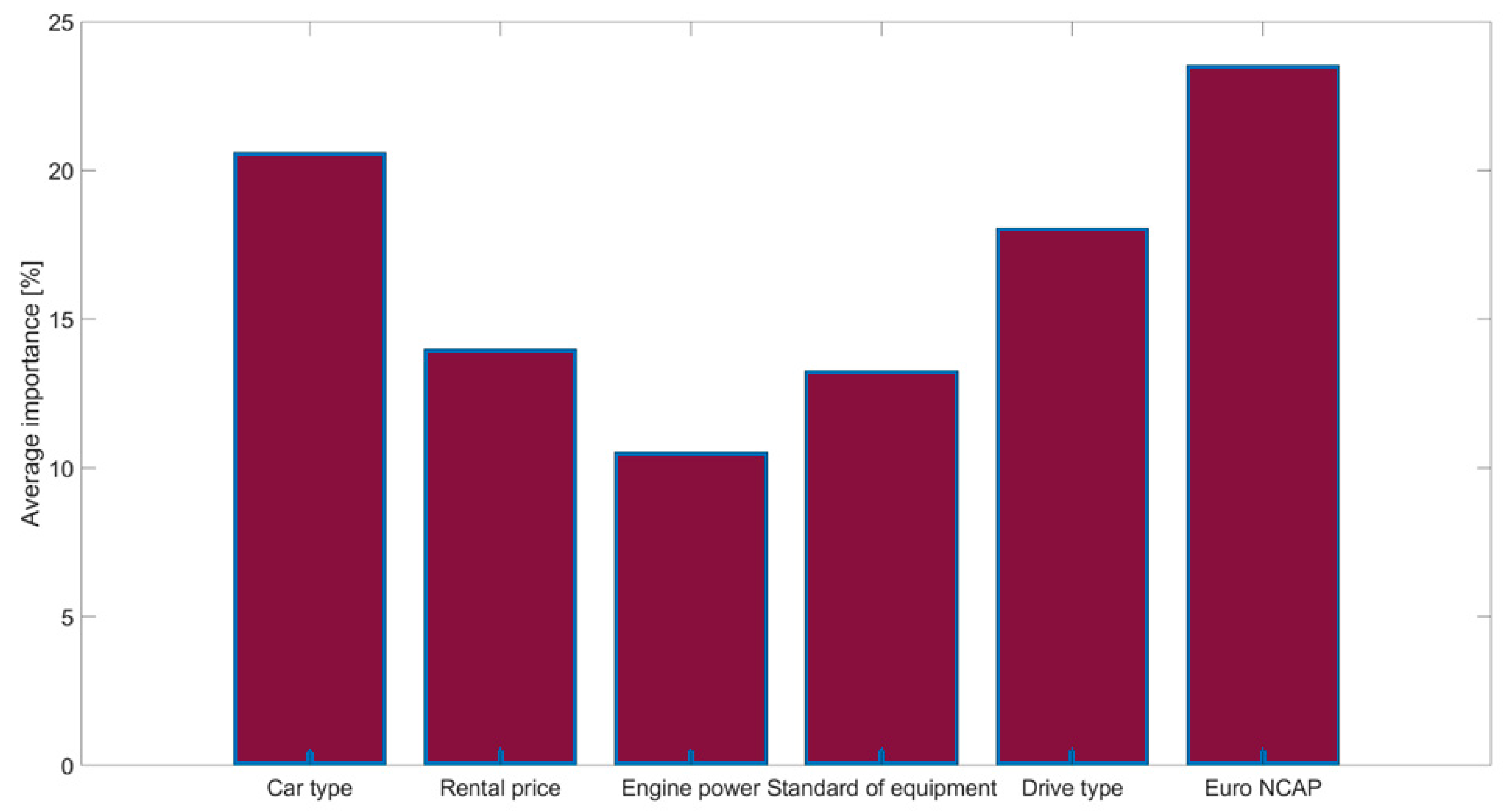
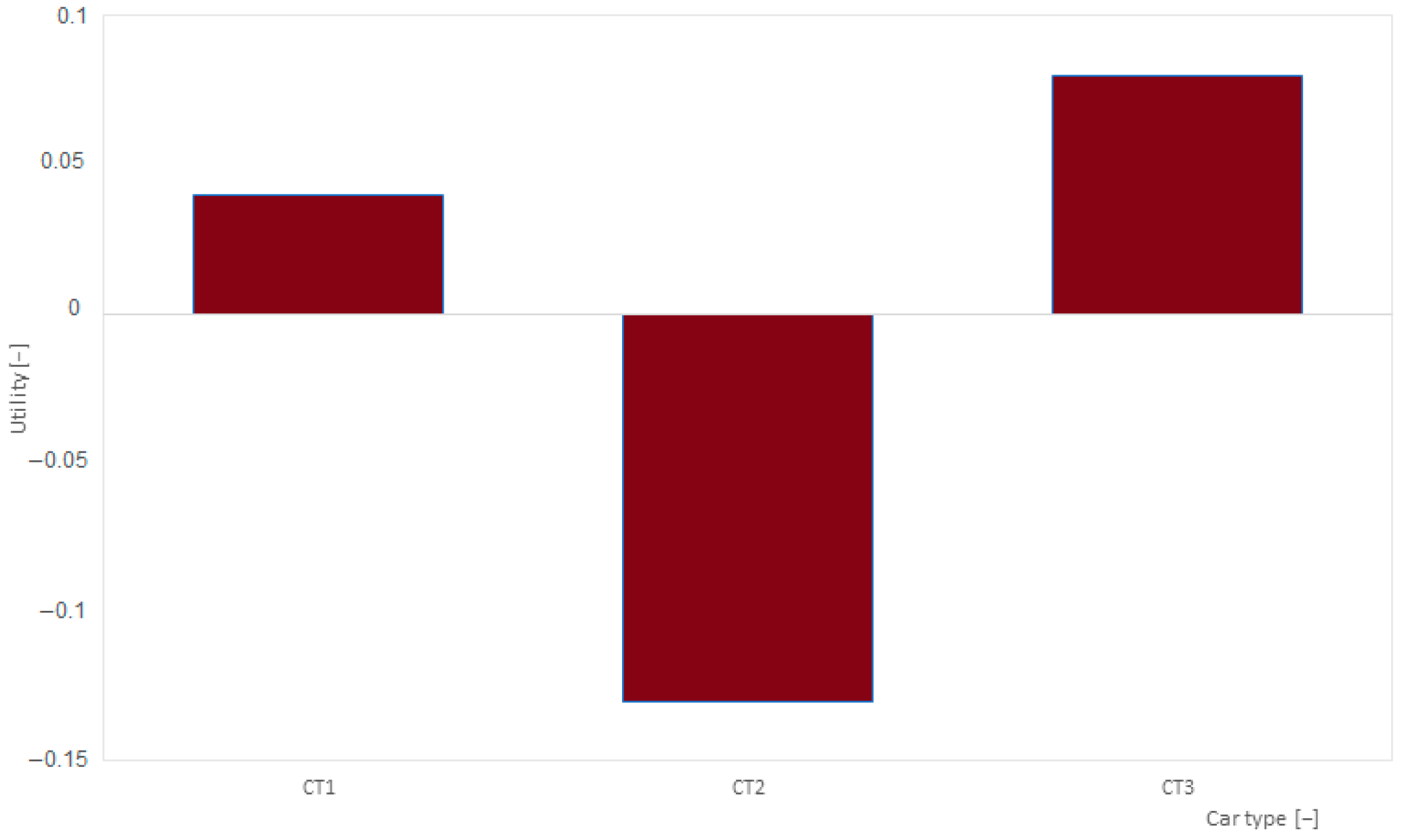
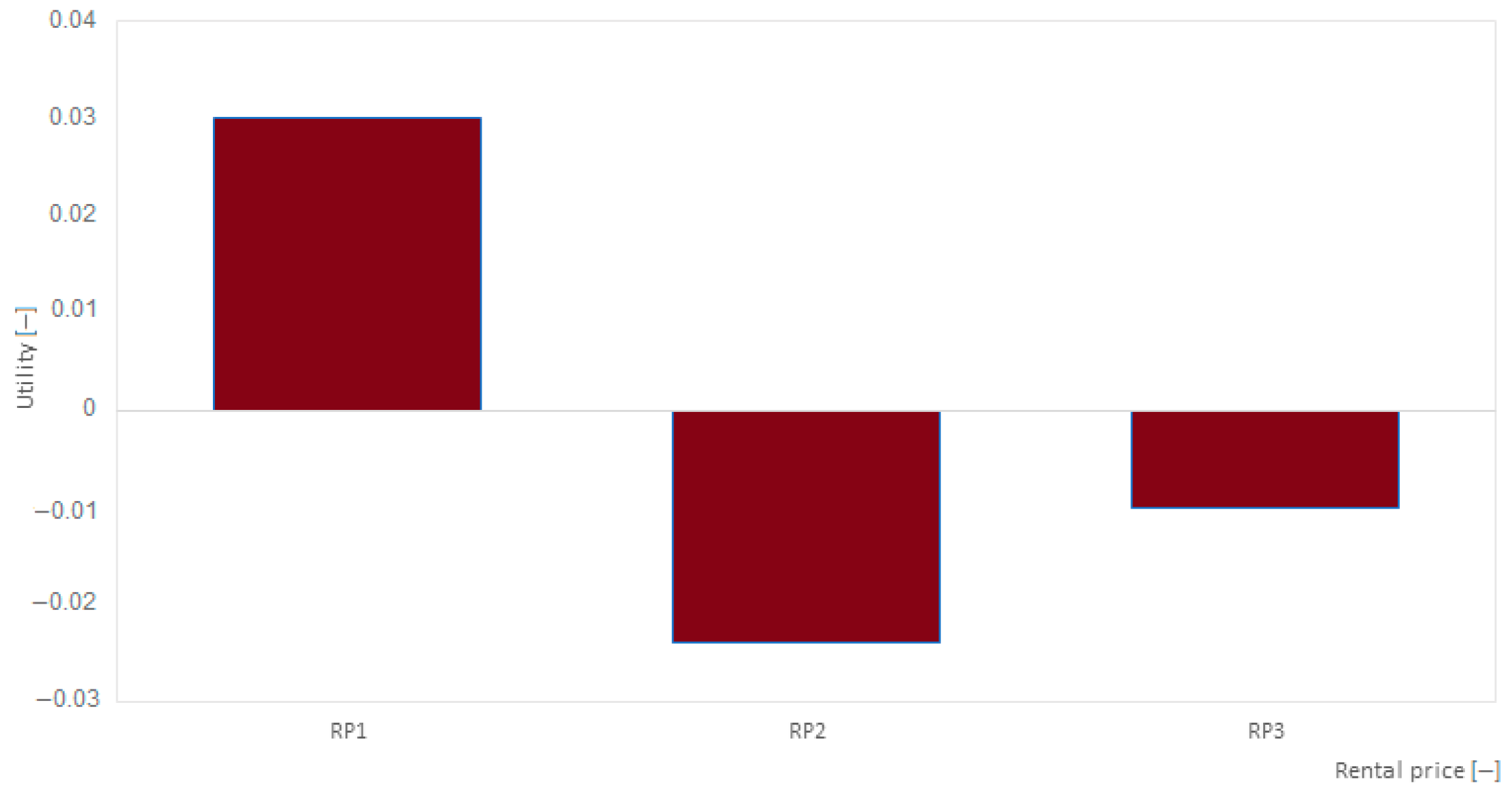
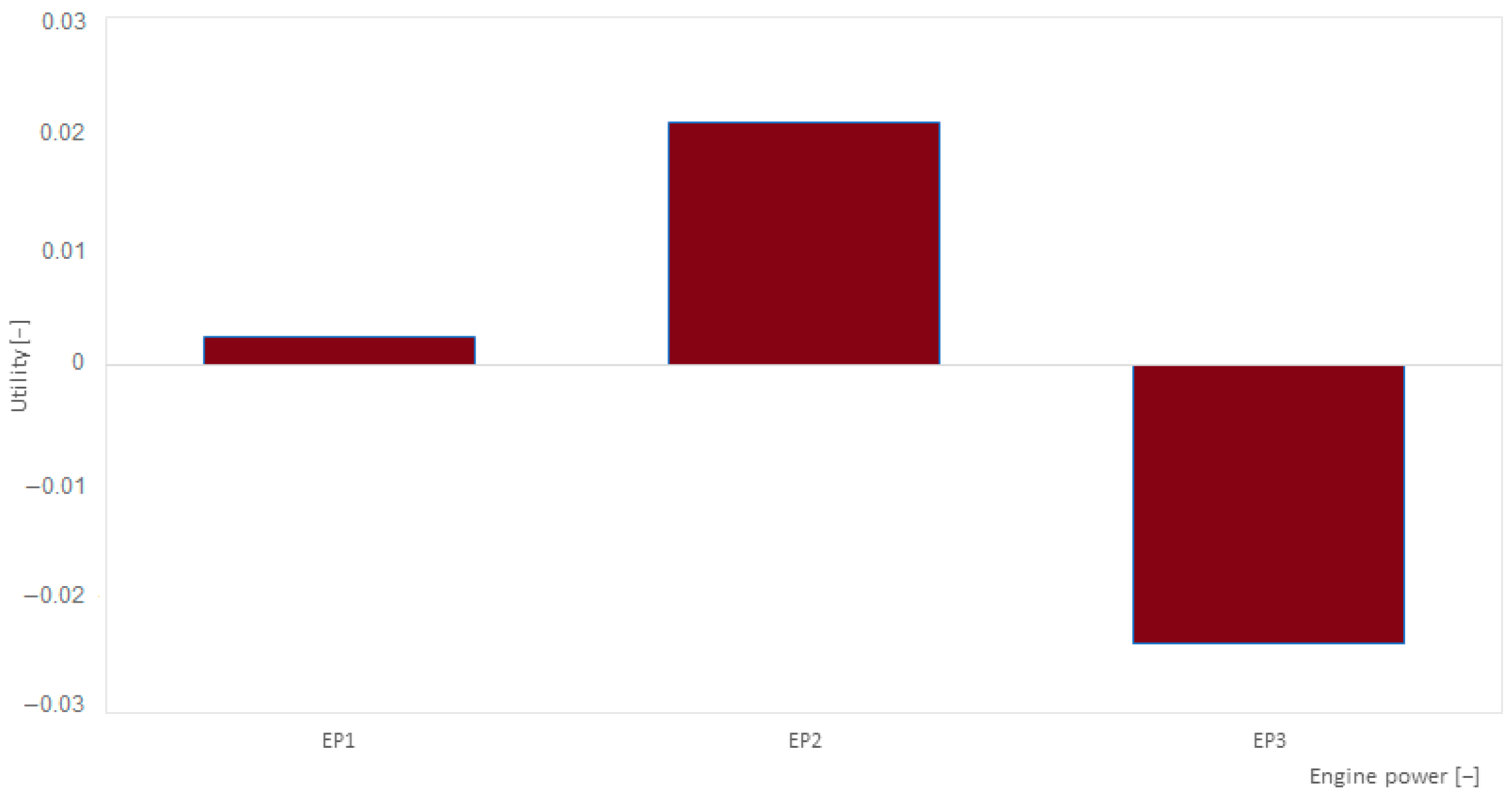
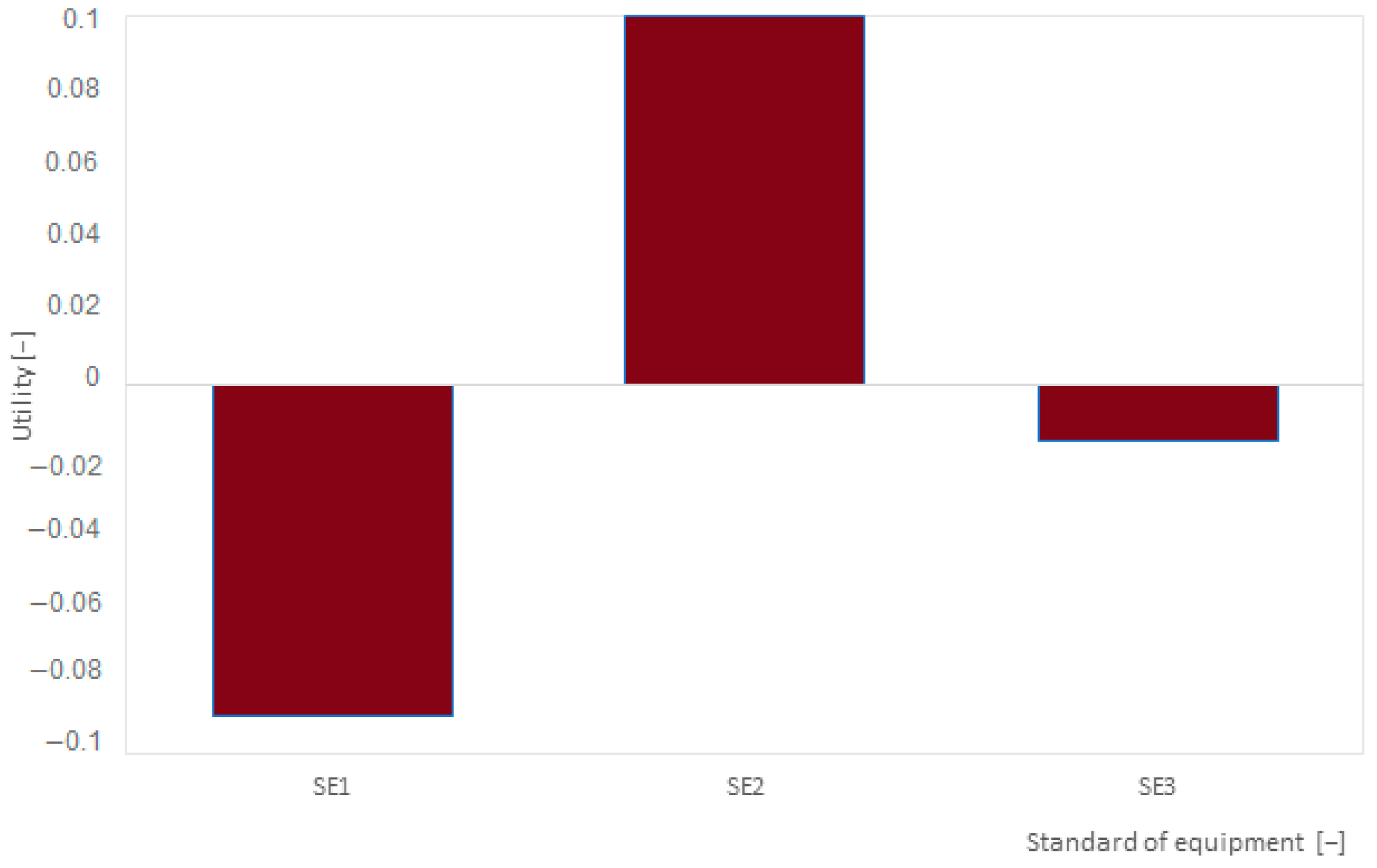

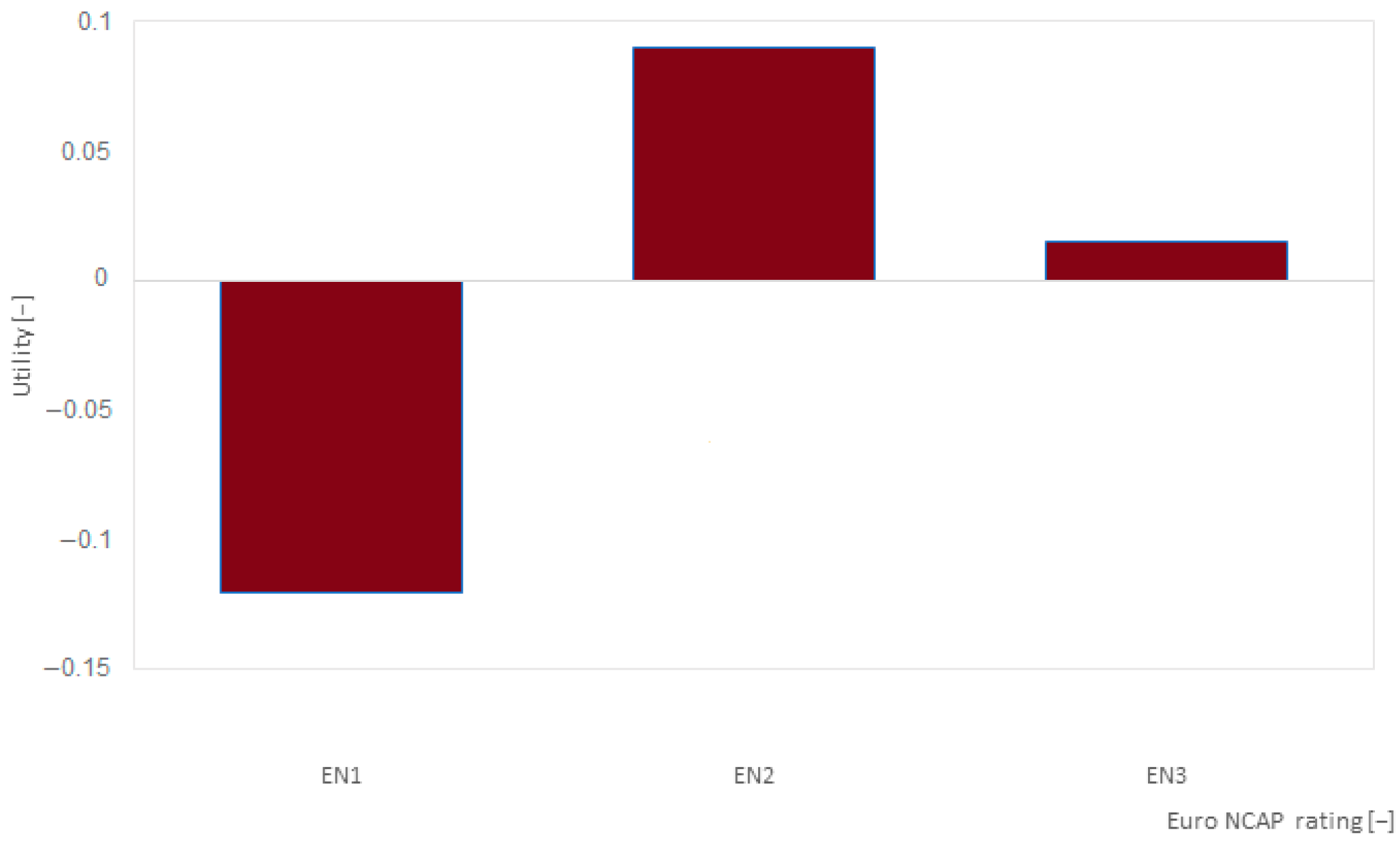
| Travel Purpose: …. | |||||||
|---|---|---|---|---|---|---|---|
| Attributes Examples | Average Rental Price | Car Type | Vulnerable Road User (VRU) Protection Rate | Luggage Compartment Capacity (Seats Up) | Engine Power | Safety Assist Rate | Average Rental Price |
| Levels | 1 | 2 | 5 | 2 | 3 | 5 | 1 |
| 4 | 1 | 2 | 3 | 1 | 3 | 3 | |
| 3 | 3 | 3 | 2 | 2 | 4 | 2 | |
| 2 | 2 | 1 | 3 | 2 | 5 | 1 | |
| … | … | … | … | … | … | … | |
| Attribute | Quasi-Experimental Coding | ||
|---|---|---|---|
| Z1 | X1 | X2 | X3 |
| Level I | 1 | 0 | 0 |
| Level II | 0 | 1 | 0 |
| Level III | −1 | −1 | −1 |
| Attribute | Quasi-Experimental Coding | ||
|---|---|---|---|
| Z1 | |||
| Level I | 0 | ||
| Level II | 0 | ||
| Level III | |||
| Feature | Detailed Data |
|---|---|
| Type of business model of the system | For profit: B2C/B2B |
| type of system operating model | Free-floating |
| Area/areas of operation | Berlin city area |
| Vehicle rental price list | 0.40—over a 0.91 [€/km] + 1€ Unlock Fee (2€ premium vehicles) + 0.29€/min stopover + Reservation (10 min for free) |
| Types of available rental offers | min/km/long-term offers. |
| Attribute | Attribute Levels |
|---|---|
| Car type [-] | 1. Small 2. Medium 3. Large |
| The average car-sharing vehicle rental price [€/km] | 1. 0.40–0.60 [€/km] 2. 0.61–0.90 [€/km] 3. over 0.91 [€/km] |
| Engine power [kW] | 1. 40–62 [kW] 2. 63–149 [kW] 3. over 150 [kW] |
| Car-sharing vehicle equipment standard [-] | 1. Parking sensors, navigation, handsfree, lane assistant, heated seats, cruise control 2. Parking sensors, navigation, handsfree, lane assistant, heated seats 3. Parking sensors |
| Drive type of the vehicle [-] | 1. Electric engine 2. Internal Combustion Engine 3. Hybrid engine |
| Euro NCAP rating [-] | 1. 1–3 stars 2. 3–4 stars 3. 5 stars |
| Attributes | Car Type [-] | The Average Car-Sharing Vehicle Rental Price [€/km] | Engine Power [kW] | Car-Sharing Vehicle Equipment Standard [-] | Drive Type of the Vehicle [-] | Euro NCAP Rating [-] |
|---|---|---|---|---|---|---|
| Levels | 1 | 1 | 2 | 3 | 1 | 2 |
| 1 | 1 | 1 | 3 | 2 | 1 | |
| 1 | 1 | 1 | 3 | 1 | 2 | |
| 1 | 1 | 1 | 3 | 2 | 2 | |
| 1 | 1 | 3 | 2 | 1 | 3 | |
| 1 | 1 | 2 | 2 | 2 | 2 | |
| 2 | 3 | 2 | 2 | 1 | 2 | |
| 2 | 2 | 2 | 2 | 3 | 3 | |
| 2 | 2 | 2 | 2 | 2 | 3 | |
| 3 | 3 | 3 | 1 | 1 | 3 | |
| 3 | 3 | 2 | 2 | 2 | 3 | |
| 3 | 3 | 3 | 1 | 1 | 3 | |
| 3 | 3 | 3 | 1 | 2 | 3 |
| Feature | Number of Respondents [-] | Number of Respondents [%] |
|---|---|---|
| Age | ||
| 18–25 | 836 | 53.21% |
| 26–35 | 403 | 25.65% |
| 36–45 | 254 | 16.17% |
| 46–55 | 40 | 2.55% |
| Over 55 | 38 | 2.42% |
| Sex | ||
| Women | 417 | 26.54% |
| Men | 1154 | 73.45% |
| Domicile | ||
| Village | 74 | 4.71% |
| City up to 50,000 inhabitants | 194 | 12.35% |
| City up to 100,000 inhabitants | 386 | 24.57% |
| City up to 250,000 inhabitants | 426 | 27.12% |
| City over 250,000 inhabitants | 491 | 31.25% |
| Professional situation | ||
| Learning | 562 | 35.77% |
| Working | 691 | 43.98% |
| Unemployed | 26 | 1.65% |
| Pensioner | 18 | 1.15% |
| Learning and working | 274 | 17.44% |
| Family status | ||
| Bachelor/Maiden | 1022 | 65.05% |
| Married | 538 | 34.25% |
| Divorced/Divorced | 11 | 0.70% |
| Monthly earnings | ||
| Up to EUR 1500 | 532 | 33.86% |
| EUR 1501—EUR 2500 | 432 | 27.50% |
| EUR 2501—EUR 4500 | 321 | 20.43% |
| over EUR 4501 | 286 | 18.20% |
| Education | ||
| Basic | 3 | 0.19% |
| Junior high school | 45 | 2.86% |
| Basic vocational | 35 | 2.23% |
| High school | 782 | 49.78% |
| Higher | 706 | 44.94% |
Disclaimer/Publisher’s Note: The statements, opinions and data contained in all publications are solely those of the individual author(s) and contributor(s) and not of MDPI and/or the editor(s). MDPI and/or the editor(s) disclaim responsibility for any injury to people or property resulting from any ideas, methods, instructions or products referred to in the content. |
© 2024 by the author. Licensee MDPI, Basel, Switzerland. This article is an open access article distributed under the terms and conditions of the Creative Commons Attribution (CC BY) license (https://creativecommons.org/licenses/by/4.0/).
Share and Cite
Turoń, K. Personalization of the Car-Sharing Fleet Selected for Commuting to Work or for Educational Purposes—An Opportunity to Increase the Attractiveness of Systems in Smart Cities. Smart Cities 2024, 7, 1670-1705. https://doi.org/10.3390/smartcities7040066
Turoń K. Personalization of the Car-Sharing Fleet Selected for Commuting to Work or for Educational Purposes—An Opportunity to Increase the Attractiveness of Systems in Smart Cities. Smart Cities. 2024; 7(4):1670-1705. https://doi.org/10.3390/smartcities7040066
Chicago/Turabian StyleTuroń, Katarzyna. 2024. "Personalization of the Car-Sharing Fleet Selected for Commuting to Work or for Educational Purposes—An Opportunity to Increase the Attractiveness of Systems in Smart Cities" Smart Cities 7, no. 4: 1670-1705. https://doi.org/10.3390/smartcities7040066






